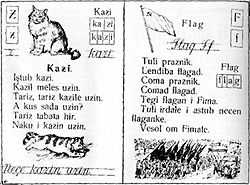The Veps language (also known as Vepsian, natively as vepsän kel’, vepsän keli, or vepsä), spoken by the Vepsians (also known as Veps), belongs to the Finnic group of the Uralic languages. Closely related to Finnish and Karelian, Veps is also written using Latin script.
According to Soviet statistics, 12,500 people were self-designated ethnic Veps at the end of 1989.
According to the location of the people, the language is divided into three main dialects: Northern Veps (at Lake Onega to the south of Petrozavodsk, to the north of the river Svir, including the former Veps National Volost), Central Veps (in the Saint Petersburg region and Vologda Oblast), and Southern Veps (in the Saint Petersburg region). The Northern dialect seems the most distinct of the three; however, it is still possible for speakers of one dialect group to understand those of another. Speakers of the Northern dialect call themselves "Ludi" (lüdikad), or lüdilaižed.
In Russia, more than 350 children learn the Vepsian language in a total of 5 national schools.[3]
Grammar
Veps is an agglutinating language.
Nouns

A Soviet textbook for native speakers of Veps printed in the 1930s.
There are 23 grammatical cases, it's more than in other Finnic languages.
| Case |
Singular |
Plural |
|---|
| Nominative |
nado (sister-in-law) |
nadod |
| Genitive |
nadon |
nadoid'en or nadoiden |
| Accusative |
nadon, nado (in some cases) |
nadod |
| Partitive |
nadod |
nadoid |
| Translative |
nadoks |
nadoikš |
| Abessive |
nadota |
nadoita |
| Comitative |
nadonke |
nadoidenke |
| Inessive |
nados |
nadoiš |
| Elative |
nadospäi |
nadoišpäi |
| Illative |
nadoho |
nadoihe |
| Adessive |
nadol |
nadoil |
| Ablative |
nadolpäi |
nadoilpäi |
| Allative |
nadole |
nadoile |
| Essive-Instructive |
nadon |
nadoin |
| Prolative |
nadodme |
nadoidme |
| Approximative I |
nadonno |
nadoidenno |
| Approximative II |
nadonnoks |
nadoidennoks |
| Egressive |
nadonnopäi |
nadoidennopäi |
| Terminative I |
mechasai 'till the forest' |
mecoihesai 'till the forests' |
| Terminative II |
nadolesai |
nadoilesai |
| Terminative III |
noressai 'from young days' |
-- |
| Additive I |
mechapäi 'in the direction of the forest' |
mecoihepäi 'in the direction of the forests' |
| Additive II |
nadolepäi |
nadoilepäi |
Personal pronouns
The personal pronouns are of Finno-Ugric origin:
| Veps |
English |
|---|
| minä |
I |
| sinä |
you |
| hän |
he/she/it |
| mö |
we |
| tö |
you (plural) |
| hö |
they |
Numbers
| Number |
Veps |
|---|
| 1 |
üks' |
| 2 |
kaks' |
| 3 |
koume |
| 4 |
nell' |
| 5 |
viž |
| 6 |
kuz' |
| 7 |
seičeme |
| 8 |
kahesa |
| 9 |
ühesa |
| 10 |
kümne |
| 11 |
üks'toštkümne |
| 12 |
kaks'toštkümne |
| 20 |
kaks'kümne |
| 34 |
koumekümne nell' |
| 100 |
sada |
| 1000 |
tuha |
Writing system
The modern Vepsian alphabet is a Latin alphabet.[4] It consists of a total of twenty-nine characters: twenty-two are from the basic modern Latin alphabet, six are derived from basic Latin letters by the addition of diacritical marks, and the final character is the apostrophe, which signifies palatalization of the preceding sound.
| Majuscule Forms (also called uppercase or capital letters) |
| A | B | C | Č | D | E | F | G | H | I | J | K | L | M | N | O | P | R | S | Š | Z | Ž | T | U | V | Ü | Ä | Ö | ' |
| Minuscule Forms (also called lowercase or small letters) |
| a | b | c | č | d | e | f | g | h | i | j | k | l | m | n | o | p | r | s | š | z | ž | t | u | v | ü | ä | ö | ' |
Language example

Road sign in Shyoltozero in Russian and Veps.
Article 1 of the Universal Declaration of Human Rights:
- Kaik mehed sünduba joudajin i kohtaižin, ühtejiččin ičeze arvokahudes i oiktusiš. Heile om anttud mel’ i huiktusentund i heile tariž kožuda toine toiženke kut vel’l’kundad.[5]
- (English version: All human beings are born free and equal in dignity and rights. They are endowed with reason and conscience and should act towards one another in a spirit of brotherhood).[6]
See also
References
External links
|
|---|
| | Federal language | |
|---|
| | Languages of federal subjects | |
|---|
| | Scripts |
- Cyrillic
- Cyrillic Braille
|
|---|
|

